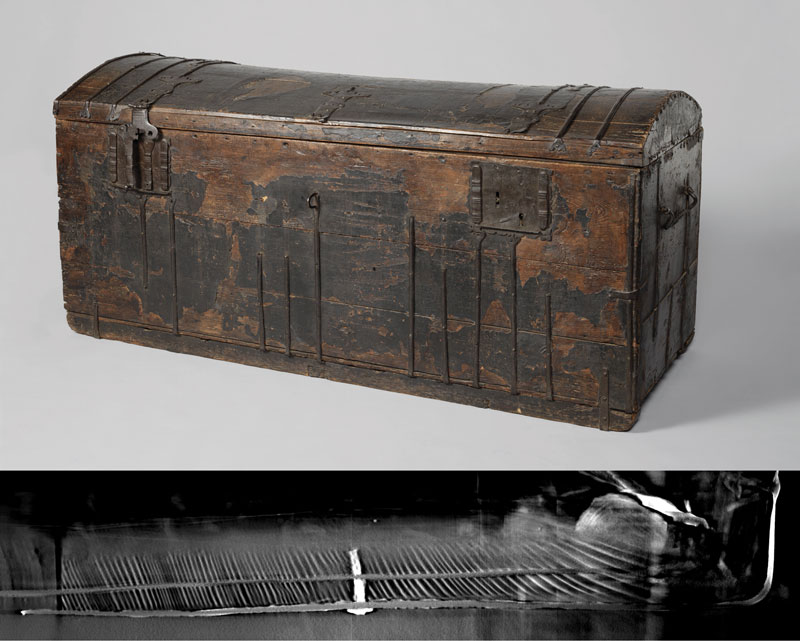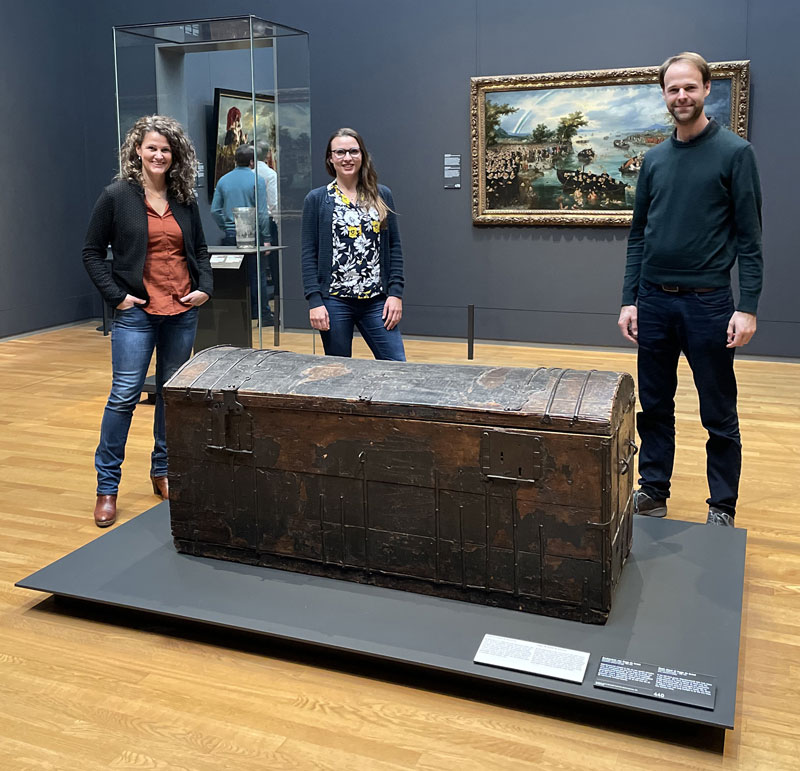by Francien G. Bossema (CWI), Marta Domínguez-Delmás (UvA) and Jan Dorscheid (Rijksmuseum)
A team of researchers from Centrum Wiskunde & Informatica (CWI), Universiteit van Amsterdam (UvA), Rijksmuseum and Universiteit Leiden (UL) have been awarded the NWO Team Science Award 2021 for their research on the Hugo de Groot book chest, which was instigated by a Dutch TV programme in 2020. Using advanced imaging techniques and algorithms, the Computational Imaging group at CWI conceived a tailored X-ray imaging technique to provide X-ray CT images at CWI of the transverse section of the wooden planks for analysis of the tree rings.
In 2020, the producers of TV series Historisch Bewijs placed the authenticity of iconic historical objects from the Rijksmuseum collection in Amsterdam under investigation. One of the objects was a large bookchest, on permanent loan from the Koninklijk Oudheidkundig Genootschap, which supposedly served to hide Dutch jurist and humanist Hugo de Groot (1583-1645) during his escape from imprisonment at Castle Loevestein in 1621. His escape is a well-known historical event that all Dutch children learn about at school.
The Rijksmuseum exhibits one of the bookchests thought to be the one used by Hugo de Groot. Another likely candidate is in possession of Museum Prinsenhof in Delft and a third is owned by Slot Loevestein. The question was: Is it possible to determine which of these chests, if any, is the original one in which Hugo de Groot escaped Castle Loevestein? One way to approach this was by exclusion. If the trees used to make the chests, were cut after the escape year of 1621, that chest could be discarded. Dendrochronology (tree-ring science) could therefore be used to date the wood and possibly provide the answer.
The chests posed a challenge for dendrochronological research, as the transverse section of the wood, on which tree-ring widths are preferably measured, was inaccessible in most pine boards: it was covered either by other boards, by leather, or by metal fittings used for structural reinforcement. Therefore, the researchers decided to resort to X-ray imaging techniques to retrieve the tree-ring patterns through non-invasive methods and date them subsequently following standard dendrochronological procedures. The large size of the chests limited the possibilities of implementing computed tomography (CT) scanning, which prompted the investigation of alternative scanning trajectories.
The team efforts that followed led to the development of a new scanning method for large wooden objects. Due to the particular shape of tree rings (they appear as lines in a cross-section), the researchers discovered that they can be perfectly captured in X-ray images taken along a line trajectory, whereby the object is moved only sideways during scanning (as opposed to fully rotated in conventional CT). In this way, an X-ray series of 1000 to 2000 images is taken of a single plank, each X-ray image showing the tree rings from a slightly different angle. Those X-ray images were then processed through tailor-made reconstruction algorithms to produce tomographic images of the cross-section of the wood, in which ring widths could be measured for dendrochronological purposes. This procedure yielded enough information to obtain sharp images of the tree rings (neatly capturing rings as narrow as 0.34 mm in test planks) which could then be used for dendrochronological measurements.
The technique represents a breakthrough for non-invasive dendrochronological research of large wooden objects from cultural heritage, and could only be achieved by combining the expertise of mathematicians, computer scientists, a dendrochronologist, furniture conservators and a technical art historian. This research led to a variety of output, including the episode of Historisch Bewijs, a blog post, and a peer-reviewed article in Scientific Reports [1]. This manuscript features the bookchest as case study and discusses the newly developed scanning method with simulations and wooden test objects.
Although the technique made it possible to visualise the tree rings in the planks, no candidate was eliminated based on dendrochronological results. Nevertheless, other evidence was put forward, about the size of the chest. As it was reported that Hugo de Groot sat very tightly in the chest, the Rijksmuseum chest was concluded to be too large.

Hugo de Groot Bookchest (Rijksmuseum) and a detail of the image obtained using the line trajectory X-ray tomography technique, showing the tree rings.

Team members with the Hugo de Groot Bookchest. From left to right: dendrochronologist Marta Domínguez Delmás (UvA), mathematician Francien Bossema (CWI) and furniture conservator Jan Dorscheid (Rijksmuseum).
NWO Team Science Award
The NWO Team Science Award is a recognition ‘for the most inspiring, diverse and successful team of researchers’. The committee praised “the team’s talent development by giving chances to the junior researchers” and stated: “The disciplines that the team brings together are surprising and complement each other. The team needs its members to work together to answer their research questions and all the team members have added value”.
“This is phenomenal, no one was able to do this thus far”, said Dr. Robert van Langh, head of Conservation and Science at the Rijksmuseum in in the TV progamme in 2020, referring to the X-ray line-trajectory tomography imaging method that the team developed.
The research team consisted of experts from a variety of disciplines within the humanities (archaeometry, technical art history, conservation and restoration) and the physical sciences (mathematics, computer sciences). The team members were Francien Bossema (CWI, Rijksmuseum), Marta Domínguez-Delmás (UvA, Rijksmuseum) and Jan Dorscheid (Rijksmuseum), Sophia Coban (CWI), Alexander Kostenko (CWI), Willem-Jan Palenstijn (CWI), Paul van Duin (Rijksmuseum), Erma Hermens (UvA, Rijksmuseum) and Joost Batenburg (CWI/Leiden University).
Links:
[L1] Dutch TV items: https://www.npostart.nl/historisch-bewijs/04-03-2020/AT_2127977 and https://www.npostart.nl/historisch-bewijs-extra/04-03-2020/WO_AT_15997049
[L2] Computational Imaging group at CWI: https://www.cwi.nl/research/groups/computational-imaging
[L3] YouTube video about the FleX-ray Lab at CWI: https://youtu.be/6Zjm_L-cXEc
References:
[1] F. G. Bossema et al.: “A novel method for dendrochronology of large historical wooden objects using line trajectory X-ray tomography”, 2021, https://doi.org/10.1038/s41598-021-90135-4
[2] F. Bossema, et al.: “A novel method for dendrochronology of large historical wooden objects using line trajectory X-ray tomography", Scientific Reports 11, 11024 (2021), www.nature.com/articles/s41598-021-90135-4
Please contact:
Marta Domínguez Delmás, University of Amsterdam, The Netherlands
Francien Bossema, CWI, The Netherlands
Jan Dorscheid, Rijksmuseum, The Netherlands.











